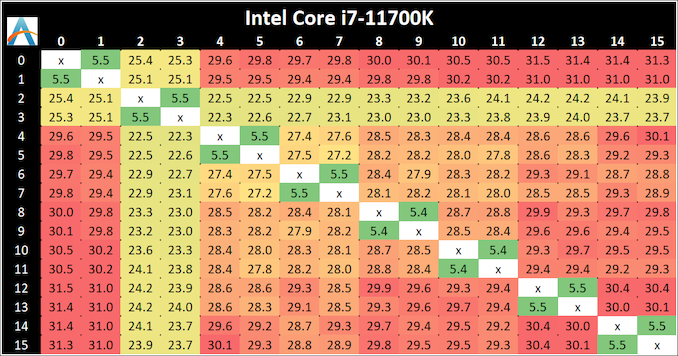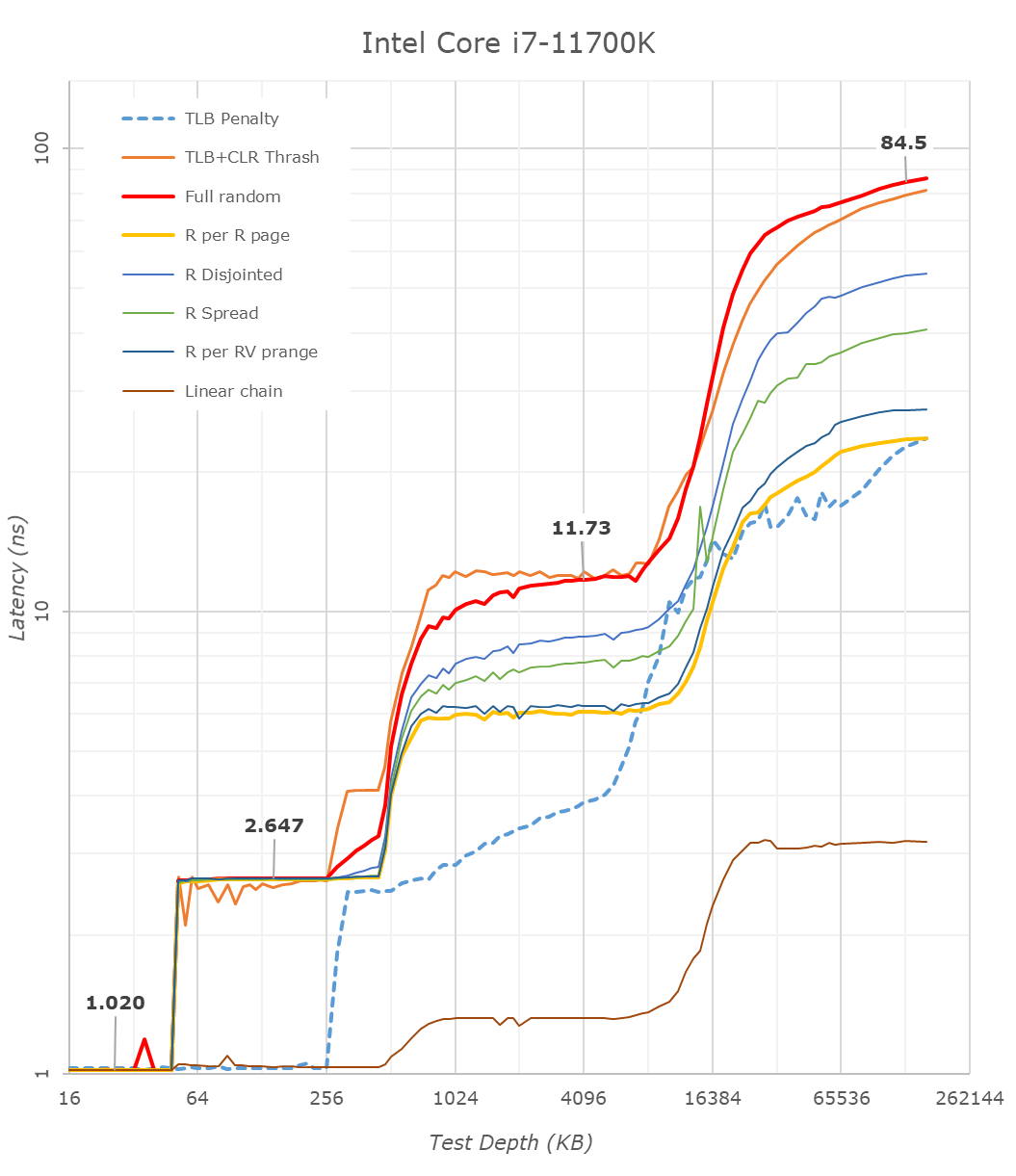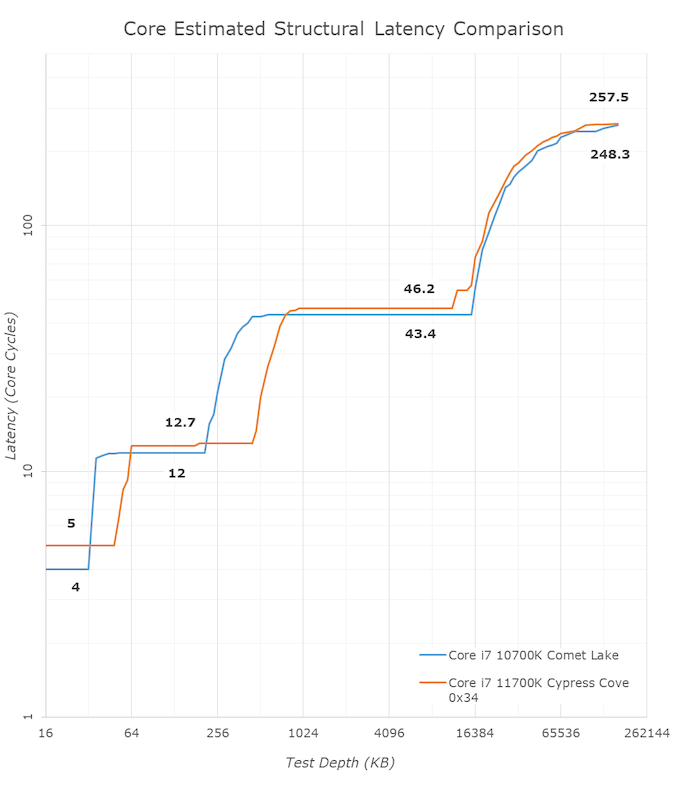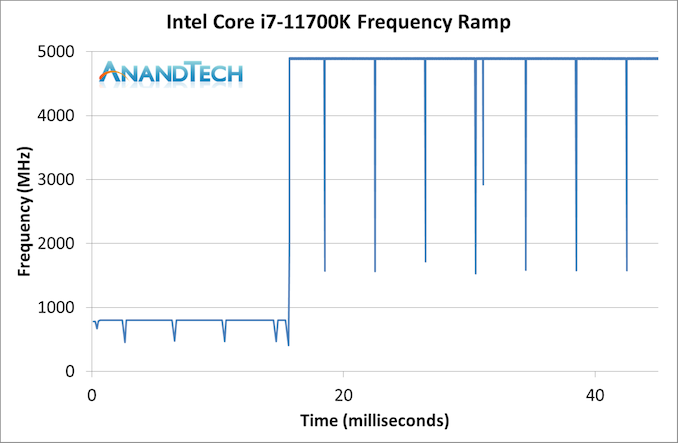Intel Core i7-11700K Review: Blasting Off with Rocket Lake
by Dr. Ian Cutress on March 5, 2021 4:30 PM EST- Posted in
- CPUs
- Intel
- 14nm
- Xe-LP
- Rocket Lake
- Cypress Cove
- i7-11700K
CPU Tests: Microbenchmarks
Core-to-Core Latency
As the core count of modern CPUs is growing, we are reaching a time when the time to access each core from a different core is no longer a constant. Even before the advent of heterogeneous SoC designs, processors built on large rings or meshes can have different latencies to access the nearest core compared to the furthest core. This rings true especially in multi-socket server environments.
But modern CPUs, even desktop and consumer CPUs, can have variable access latency to get to another core. For example, in the first generation Threadripper CPUs, we had four chips on the package, each with 8 threads, and each with a different core-to-core latency depending on if it was on-die or off-die. This gets more complex with products like Lakefield, which has two different communication buses depending on which core is talking to which.
If you are a regular reader of AnandTech’s CPU reviews, you will recognize our Core-to-Core latency test. It’s a great way to show exactly how groups of cores are laid out on the silicon. This is a custom in-house test built by Andrei, and we know there are competing tests out there, but we feel ours is the most accurate to how quick an access between two cores can happen.
The core-to-core numbers are interesting, being worse (higher) than the previous generation across the board. Here we are seeing, mostly, 28-30 nanoseconds, compared to 18-24 nanoseconds with the 10700K. This is part of the L3 latency regression, as shown in our next tests.
One pair of threads here are very fast to access all cores, some 5 ns faster than any others, which again makes the layout more puzzling.
Update 1: With microcode 0x34, we saw no update to the core-to-core latencies.
Cache-to-DRAM Latency
This is another in-house test built by Andrei, which showcases the access latency at all the points in the cache hierarchy for a single core. We start at 2 KiB, and probe the latency all the way through to 256 MB, which for most CPUs sits inside the DRAM (before you start saying 64-core TR has 256 MB of L3, it’s only 16 MB per core, so at 20 MB you are in DRAM).
Part of this test helps us understand the range of latencies for accessing a given level of cache, but also the transition between the cache levels gives insight into how different parts of the cache microarchitecture work, such as TLBs. As CPU microarchitects look at interesting and novel ways to design caches upon caches inside caches, this basic test proves to be very valuable.
Looking at the rough graph of the 11700K and the general boundaries of the cache hierarchies, we again see the changes of the microarchitecture that had first debuted in Intel’s Sunny Cove cores, such as the move from an L1D cache from 32KB to 48KB, as well as the doubling of the L2 cache from 256KB to 512KB.
The L3 cache on these parts look to be unchanged from a capacity perspective, featuring the same 16MB which is shared amongst the 8 cores of the chip.
On the DRAM side of things, we’re not seeing much change, albeit there is a small 2.1ns generational regression at the full random 128MB measurement point. We’re using identical RAM sticks at the same timings between the measurements here.
It’s to be noted that these slight regressions are also found across the cache hierarchies, with the new CPU, although it’s clocked slightly higher here, shows worse absolute latency than its predecessor, it’s also to be noted that AMD’s newest Zen3 based designs showcase also lower latency across the board.
With the new graph of the Core i7-11700K with microcode 0x34, the same cache structures are observed, however we are seeing better performance with L3.
The L1 cache structure is the same, and the L2 is of a similar latency. In our previous test, the L3 latency was 50.9 cycles, but with the new microcode is now at 45.1 cycles, and is now more in line with the L3 cache on Comet Lake.
Out at DRAM, our 128 MB point reduced from 82.4 nanoseconds to 72.8 nanoseconds, which is a 12% reduction, but not the +40% reduction that other media outlets are reporting as we feel our tools are more accurate. Similarly, for DRAM bandwidth, we are seeing a +12% memory bandwidth increase between 0x2C and 0x34, not the +50% bandwidth others are claiming. (BIOS 0x1B however, was significantly lower than this, resulting in a +50% bandwidth increase from 0x1B to 0x34.)
In the previous edition of our article, we questioned the previous L3 cycle being a larger than estimated regression. With the updated microcode, the smaller difference is still a regression, but more in line with our expectations. We are waiting to hear back from Intel what differences in the microcode encouraged this change.
Frequency Ramping
Both AMD and Intel over the past few years have introduced features to their processors that speed up the time from when a CPU moves from idle into a high powered state. The effect of this means that users can get peak performance quicker, but the biggest knock-on effect for this is with battery life in mobile devices, especially if a system can turbo up quick and turbo down quick, ensuring that it stays in the lowest and most efficient power state for as long as possible.
Intel’s technology is called SpeedShift, although SpeedShift was not enabled until Skylake.
One of the issues though with this technology is that sometimes the adjustments in frequency can be so fast, software cannot detect them. If the frequency is changing on the order of microseconds, but your software is only probing frequency in milliseconds (or seconds), then quick changes will be missed. Not only that, as an observer probing the frequency, you could be affecting the actual turbo performance. When the CPU is changing frequency, it essentially has to pause all compute while it aligns the frequency rate of the whole core.
We wrote an extensive review analysis piece on this, called ‘Reaching for Turbo: Aligning Perception with AMD’s Frequency Metrics’, due to an issue where users were not observing the peak turbo speeds for AMD’s processors.
We got around the issue by making the frequency probing the workload causing the turbo. The software is able to detect frequency adjustments on a microsecond scale, so we can see how well a system can get to those boost frequencies. Our Frequency Ramp tool has already been in use in a number of reviews.
Our ramp test shows a jump straight from 800 MHz up to 4900 MHz in around 17 milliseconds, or a frame at 60 Hz.














541 Comments
View All Comments
lmcd - Friday, March 5, 2021 - link
As an Intel fan, this is abysmal. This is literally only good for an i3 or i5 SKU, for its upgraded iGPU. That's it.Slash3 - Friday, March 5, 2021 - link
The 11th gen i3 SKUs will not feature the new Xe core - they are still based on Comet Lake.lmcd - Friday, March 5, 2021 - link
That makes this even sadder. This port was actually worthless. An i5 quad core might be manageable by a cooler that fits in an average case, but that's about it.Would've been better off releasing Tiger Lake 35W processors on an LGA package.
Slash3 - Friday, March 5, 2021 - link
The 6C/12T i5-11500 should be "fine," as it has the same 32CU Xe iGPU as the higher end parts. The part below it, the i5-11400, is also 6C/12T but has a cut down 24CU Xe core.The Xe upgrade is a nice change, at about a 33% uplift over the previous "Gen11" iGPU, but it's still just what I'd call "passable" for light gaming. Anything above 1080p and you'll want a discrete GPU for the best experience, and that goes for both teams.
lmcd - Friday, March 5, 2021 - link
I understand what you're saying but I still think the 6-core i5 is going to draw a boatload of power.Obviously for gaming a dGPU is preferable. In my experience with AMD's Ryzen 2400G, though, it isn't actually too stable with medium resolution monitor configurations (think 1080p + 1440p) and isn't all that well supported by drivers.
On the Intel side, uplift over Gen11 is cool but uplift over Gen9 is where it gets noticeable, and important. Gen9 was fine when it came out but that was quite some time ago. Shows its age when too many apps want GPU acceleration with that same multi-monitor setup I described.
lmcd - Friday, March 5, 2021 - link
Sorry, didn't complete my thought. Anyway, point is that a decent % of Intel's sales are for business desktops (maybe not right now, but, ya know, offices might open up sometime this calendar year, before Alder Lake ships in volume). Rocket Lake i5 would be perfect, if its real-world power consumption wasn't out the roof. Good enough graphics for multi-monitor, fine performance elsewhere.I guess that makes me wonder what performance would be if limited to a 65W avg/95W peak thermal output. That's about what those small Dell towers can handle.
Slash3 - Friday, March 5, 2021 - link
Yep, I'm with you.I honestly don't expect the i5 models to have the same outlandish power usage characteristics as the reviewed i7, but will definitely be reading any day one reviews that may pop up. The existing i5-10400 is a pretty compelling product (and priced well), and if the 11400 or 11500 can manage to fit into the same ~100W PL2 envelope I think it'll find a home in a lot of desktops. For OEMs, they're sometimes board limited to the 65W PL1 via a BIOS option, and I'd expect that to continue with the 11th gen versions.
If they price the 11400 close to the 10400, it'll be a solid choice.
Makaveli - Friday, March 5, 2021 - link
The Turbo for the 5800X should be 4850 that is what I see at stock. So the table is off by 50mhzSaturnusDK - Saturday, March 6, 2021 - link
Not really. AMD changed the way they report boost frequency numbers. Before it was "up to xxxxMHz boost", now it's the more wordy "given adequate cooling the boost frequency is _at least_ xxxxMHz". This change was driven by the stick they got for the 3000-series only very rarely hitting the listed boost frequency. Now you can generally assume to get 50-100MHz _above_ the listed boost frequency if you have a half-decent cooler.Marlin1975 - Friday, March 5, 2021 - link
WTF!!! 291 watts?!?!?Intel REALLY needs to step up is manufacture game. Designs seem ok but the nodes are killing them.